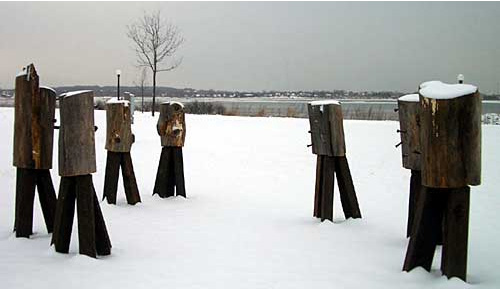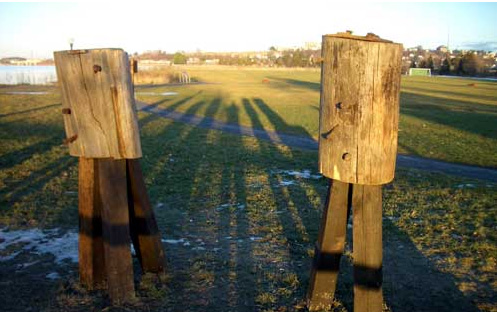Concept, History, and Process:
In mid September 2006 I walked near the railroad tracks in the Libbytown neighborhood of Portland with a group of artist colleagues. We were all looking for inspiration to make public art about that neighborhood. We were in an area with trash piles of discarded tree stumps, rusted metal and old mattresses. There was a small homeless encampment nearby in a cluster of birch trees. An old milk crate, chair and rug looked cozy on a warm late summer day in the leaf dappled sun, until we realized that whoever used this space was also here in the rain and cold, with no roof overhead.
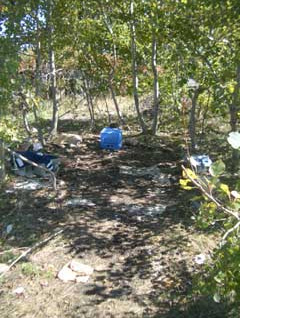
A man came by, talked with some of us, and said he appreciated that a similar group of artists had done trash pick up along the tracks last year, he hoped we were going to do the same and offered to help in such a cleanup. He appeared to be ‘down on his luck’, as some of us think of the people our society discards.

I particularly like working with found materials, both for the history they represent and for the environmental responsibility it brings to my work. I went back to the site, with help, in a couple of weeks and began hauling the large logs, and rusted metal to my studio to develop a design.
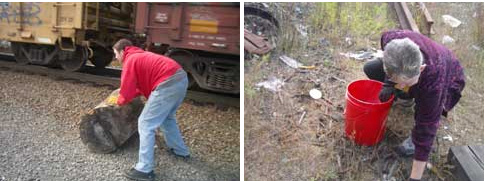
We met two men sitting on the ground, chatting in the late morning sun, who cheered us on, talked amiably about the fact that they spent a lot of time there, and invited us to return. A week later I went back for more logs and was told by some workmen, who remembered me from my last trip, that there had been an incident there a few days before. One man, who was homeless, had been badly beaten and hospitalized. Later that week the newspaper announced that two drinking buddies had been at the encampment and one was accused of beating the other, who later died. The paper made it sound as though now that the perpetrator had apparently been found, the problem would be taken care of. The discussion was one of his behavior on the night in question, his attempts to defend himself in court, and so on. There was no mention of the economic conditions that created the situation and many like it. I was deeply saddened by these events. I wanted to call attention to the harsh reality of the lives of the men and women society discards and then blames for developing coping strategies of which we do not approve.
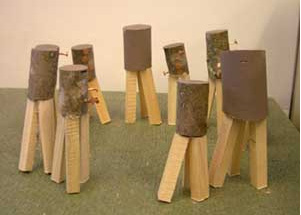
Preliminary Scale Model
Many years before I became a full time artist I spent five years as a Probation and Parole Officer for the State of Maine Department of Corrections (as it was called then). I understand that society must protect its people from violence. I also understand how people, who our wealthy society leaves with no viable options, are pushed into addictions, violence, or homelessness. I wanted to use the materials I found on the site to honor the situation of these two friends, who on their best days were part of a community that had pleasure in life and in each other, and to bring attention to economic and societal practices that discard human beings.
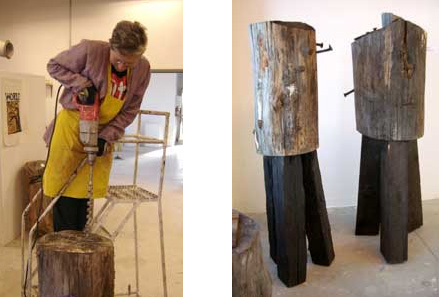
We met two men sitting on the ground, chatting in the late morning sun, who cheered us on, talked amiably about the fact that they spent a lot of time there, and invited us to return. A week later I went back for more logs and was told by some workmen, who remembered me from my last trip, that there had been an incident there a few days before. One man, who was homeless, had been badly beaten and hospitalized. Later that week the newspaper announced that two drinking buddies had been at the encampment and one was accused of beating the other, who later died. The paper made it sound as though now that the perpetrator had apparently been found, the problem would be taken care of. The discussion was one of his behavior on the night in question, his attempts to defend himself in court, and so on. There was no mention of the economic conditions that created the situation and many like it. I was deeply saddened by these events. I wanted to call attention to the harsh reality of the lives of the men and women society discards and then blames for developing coping strategies of which we do not approve.
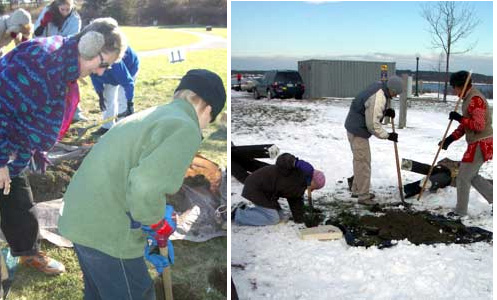
So the found logs are used in sculpture to create life sized abstract figures, damaged by iron spikes and weather, standing together in a circle, on tripod ‘legs’ that resemble railroad ties. Many people helped get the project installed.
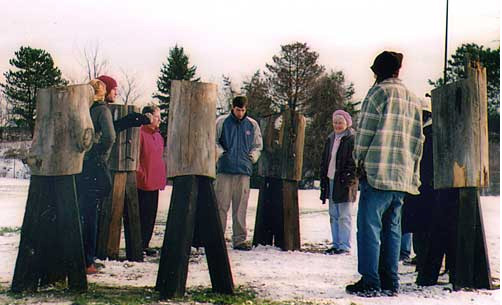
I am Jewish. In my tradition, when someone dies, there must be a community of at least ten adults (called a Minyan) to assist those who are grieving to say a special prayer for the dead (Kaddish) and to remember that life is still worth living. I have intentionally not completed ten figures, but wish to invite the viewer to join the circle and complete the community needed to grieve, and to take action in any way they can to end economic injustice and its many consequences, including violence, addictions, and homelessness.
